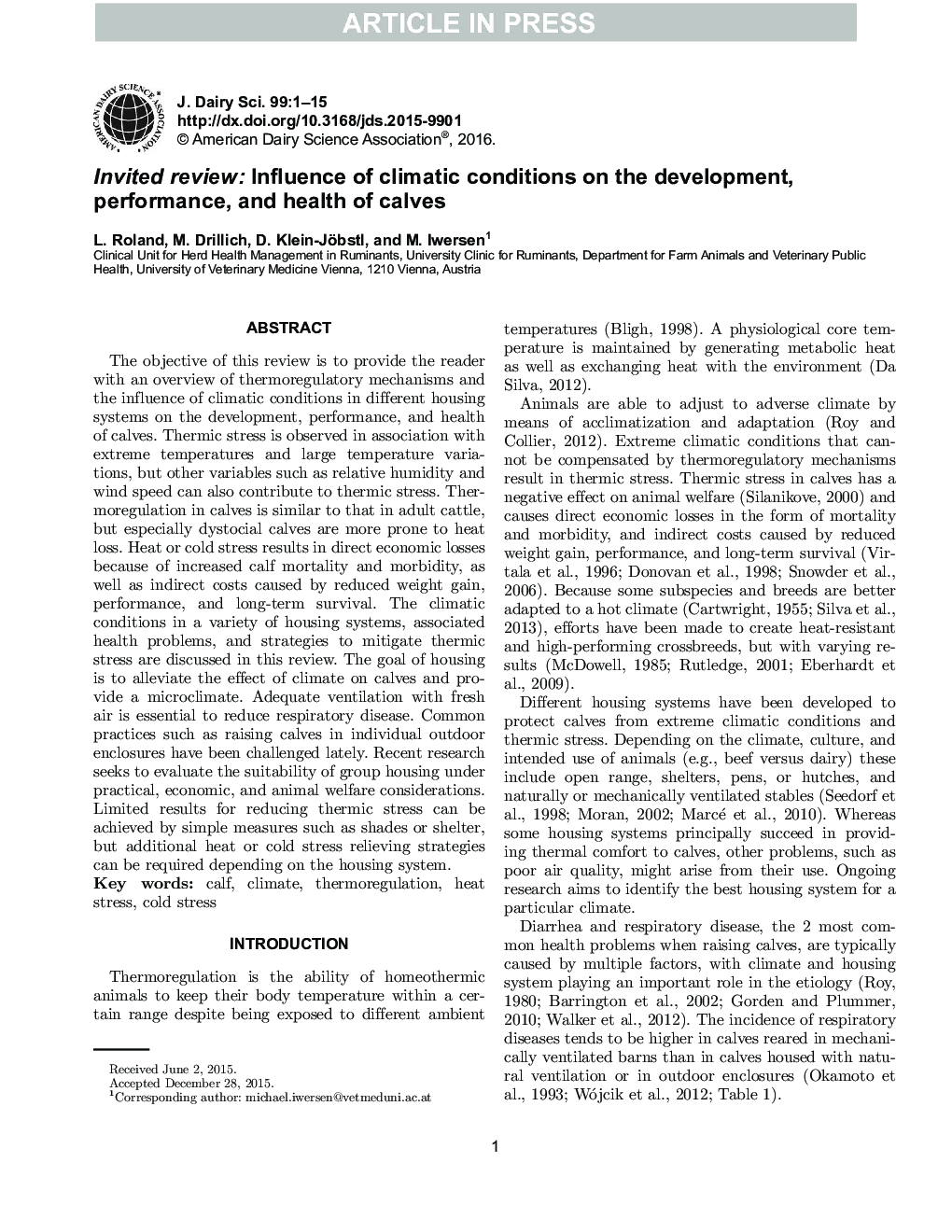| کد مقاله | کد نشریه | سال انتشار | مقاله انگلیسی | نسخه تمام متن |
|---|---|---|---|---|
| 10973046 | 1108010 | 2016 | 15 صفحه PDF | دانلود رایگان |
عنوان انگلیسی مقاله ISI
Invited review: Influence of climatic conditions on the development, performance, and health of calves
ترجمه فارسی عنوان
بررسی دعوت شده: تأثیر شرایط آب و هوایی بر توسعه، عملکرد و سلامت گوساله ها
دانلود مقاله + سفارش ترجمه
دانلود مقاله ISI انگلیسی
رایگان برای ایرانیان
کلمات کلیدی
گوساله، آب و هوا، تنظیم گرما، استرس گرما، استرس سرد،
ترجمه چکیده
هدف از این بررسی، ارائه خواننده به بررسی مکانیزم های حرارتی و تاثیر شرایط آب و هوایی در سیستم های مختلف مسکن بر توسعه، عملکرد و سلامتی گوساله ها است. تنش حرارتی در ارتباط با دمای شدید و تغییرات دما زیاد مشاهده می شود، اما متغیرهای دیگر مانند رطوبت نسبی و سرعت باد نیز می توانند به تنش گرمایشی کمک کنند. تنظیم گرما در گوساله ها مشابه آنچه در گاوهای بالغ است، اما به ویژه گوساله های دیستوسیتی بیشتر در معرض افتادن گرما هستند. استرس گرما یا سرما به علت افزایش مرگ و میر و عوارض گوساله و نیز هزینه های غیر مستقیم ناشی از کاهش وزن، عملکرد و بقای طولانی مدت باعث زیان های مستقیم اقتصادی می شود. شرایط آب و هوایی در انواع سیستم های مسکن، مشکلات مربوط به سلامت و استراتژی هایی برای کاهش استرس گرما در این بررسی مورد بحث قرار گرفته است. هدف مسکن، کاهش تاثیر آب و هوا بر روی گوساله ها و ایجاد محیطی بی نظیر است. تهویه مناسب با هوای تازه برای کاهش بیماری های تنفسی ضروری است. شیوه های معمولی مانند بالا بردن گوساله ها در محوطه های فردی در فضای باز به تازگی مورد چالش قرار گرفته است. تحقیقات اخیر به دنبال بررسی مناسب بودن مسکن گروه تحت معیارهای رفاه عملی، اقتصادی و حیوانی است. نتایج محدود برای کاهش استرس گرمایشی می تواند با اقدامات ساده مانند سایه ها یا سرپناه ها به دست آید، اما بسته به سیستم مسکن، ممکن است استراتژی های کاهش اضطراب گرم یا سرد را می توان مورد نیاز.
موضوعات مرتبط
علوم زیستی و بیوفناوری
علوم کشاورزی و بیولوژیک
علوم دامی و جانورشناسی
چکیده انگلیسی
The objective of this review is to provide the reader with an overview of thermoregulatory mechanisms and the influence of climatic conditions in different housing systems on the development, performance, and health of calves. Thermic stress is observed in association with extreme temperatures and large temperature variations, but other variables such as relative humidity and wind speed can also contribute to thermic stress. Thermoregulation in calves is similar to that in adult cattle, but especially dystocial calves are more prone to heat loss. Heat or cold stress results in direct economic losses because of increased calf mortality and morbidity, as well as indirect costs caused by reduced weight gain, performance, and long-term survival. The climatic conditions in a variety of housing systems, associated health problems, and strategies to mitigate thermic stress are discussed in this review. The goal of housing is to alleviate the effect of climate on calves and provide a microclimate. Adequate ventilation with fresh air is essential to reduce respiratory disease. Common practices such as raising calves in individual outdoor enclosures have been challenged lately. Recent research seeks to evaluate the suitability of group housing under practical, economic, and animal welfare considerations. Limited results for reducing thermic stress can be achieved by simple measures such as shades or shelter, but additional heat or cold stress relieving strategies can be required depending on the housing system.
ناشر
Database: Elsevier - ScienceDirect (ساینس دایرکت)
Journal: Journal of Dairy Science - Volume 99, Issue 4, April 2016, Pages 2438-2452
Journal: Journal of Dairy Science - Volume 99, Issue 4, April 2016, Pages 2438-2452
نویسندگان
L. Roland, M. Drillich, D. Klein-Jöbstl, M. Iwersen,
